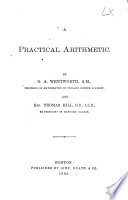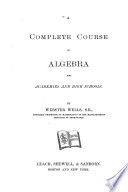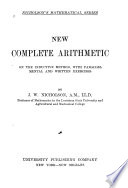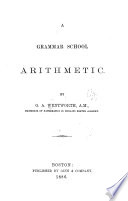 | George Albert Wentworth, Thomas Hill - Arithmetic - 1882 - 376 pages
...of figures already obtained may be found without error by division, the divisor to be employed being three times the square of the part of the root already found. 397. The cube root of a common fraction is found by taking the cube roots of the numerator and denominator... | |
 | James Bates Thomson - Algebra - 1884 - 334 pages
...the remainder. IV. If there are more than two terms in the root, for the second trial divisor, take three times the square of the part of the root already found, and completing the divisor as before, continue the operation until the root of all the terms is found.... | |
 | Webster Wells - 1885 - 368 pages
...the root by the second, and the square of the second term. Multiply the complete divisor by the term of the root last obtained, and subtract the product from the remainder. If other terms remain, proceed as before, taking three times the square of the root already found for the next... | |
 | Webster Wells - Algebra - 1885 - 324 pages
...and add the quotient to the root and also to the divisor. Multiply the complete divisor by the term of the root last obtained, and subtract the product from the remainder. If other terms remain, proceed as before, doubling the part of the root already found for the next trial-divisor.... | |
 | Webster Wells - Algebra - 1885 - 370 pages
...and add the quotient to the root and also to the divisor. Multiply the complete divisor by the term of the root last obtained, and subtract the product from the remainder. If other terms remain, proceed as before, doubling the part of the root already found for the next trial-divisor.... | |
 | James William Nicholson - Arithmetic - 1885 - 348 pages
...of figures already obtained may be found without error by division, the divisor to be employed being three times the square of the part of the root already found. RULE. — Separate the number into 3-ßgure periods, beginning with ones in an integer, and with tenths... | |
 | Webster Wells - Algebra - 1885 - 382 pages
...and add the quotient to the root and also to the divisor. Multiply the complete divisor by the term of the root last obtained, and subtract the product from the remainder. ALGEBRA. EXAMPLES. 204. 1. Find the square root of 9a^ — 30 aV + 25 a6. 3 ar — 5 a3. Ans. 9ж4... | |
 | George Albert Wentworth - Algebra - 1886 - 284 pages
...of figures already obtained may be found without error by division, the divisor to be employed being three times the square of the part of the root already found. Ex. 78. Find the cube roots of: 1. 274,625. 5. 109,215,352. 9. 2.803221. 2. 110,592. 6. 1,481,544.... | |
 | George Albert Wentworth - Arithmetic - 1886 - 392 pages
...of figures already obtained may be found without error by division, the divisor to be employed being three times the square of the part of the root already found. 282. The cube root of a common fraction is found by taking the cube roots of the numerator and denominator... | |
 | George Albert Wentworth - 1888 - 388 pages
...of figures already obtained may be found without error by division, the divisor to be employed being three times the square of the part of the root already found. 397. The cube root of a common fraction is found by taking the cube roots of the numerator and denominator... | |
| |